The Mithraeum of Dura Europos: where Aramaeans, Greeks and Romans accepted an Iranian Religion
ΑΝΑΔΗΜΟΣΙΕΥΣΗ ΑΠΟ ΤΟ ΣΗΜΕΡΑ ΑΝΕΝΕΡΓΟ ΜΠΛΟΓΚ “ΟΙ ΡΩΜΙΟΙ ΤΗΣ ΑΝΑΤΟΛΗΣ”
Το κείμενο του κ. Νίκου Μπαϋρακτάρη είχε αρχικά δημοσιευθεί την 26η Νοεμβρίου 2019. Αποτελεί συνέχεια των προηγουμένων κειμένων του τα οποία έχουν ήδη αναδημοσιευθεί εδώ:
“Δούρα Ευρωπός, το Τέλειο Πρότυπο Πολυπολιτισμικότητας: Αραμαίοι, Έλληνες, Πάρθες, Ρωμαίοι και Πέρσες σε Μοναδικό Θρησκευτικό Συγκρητισμό δίπλα στον Ευφράτη” https://www.academia.edu/66009699/Έλληνες_Πάρθες_Ρωμαίοι_και_Πέρσες_σε_Μοναδικό_Θρησκευτικό_Συγκρητισμό_δίπλα_στον_Ευφράτη
και
“Δούρα Ευρωπός, οι Ιουδαίοι Αραμαίοι, η Συναγωγή και η Νεώτερη Ψευτοϊστορία των Σιωνιστών”
https://www.academia.edu/66138539/Δούρα_Ευρωπός_οι_Ιουδαίοι_Αραμαίοι_η_Συναγωγή_και_η_Νεώτερη_Ψευτοϊστορία_των_Σιωνιστών
— — — — — — — — — — — — — — — — — —
https://greeksoftheorient.wordpress.com/2019/11/26/το-μιθραίο-της-δούρας-ευρωπού-όπου-αρα/
==================
Οι Ρωμιοί της Ανατολής — Greeks of the Orient
Ρωμιοσύνη, Ρωμανία, Ανατολική Ρωμαϊκή Αυτοκρατορία
Παιδιά ενός κατώτερου θεού και πολιτισμικά ασυγκρίτως κατώτεροι, οι απόγονοι των Ελλήνων και των Μακεδόνων των σελευκιδικών χρόνων, μαζί με τους ντόπιους Αραμαίους της Κεντρικής Μεσοποταμίας, και τους Ρωμαίους των αυτοκρατορικών χρόνων παράτησαν τους θεούς τους και λάτρευσαν τον Μίθρα, αφού ο μιθραϊσμός είχε ήδη κατακλύσει την Συρο-Παλαιστίνη, την Αρμενία, την Κομμαγηνή, τον Πόντο, την Καππαδοκία, την Μικρά Ασία, την Ελλάδα, την Ρώμη και όλη την Ευρώπη. Μαζί τους συλλειτουργούσαν Πάρθες και άλλοι Ιρανοί.
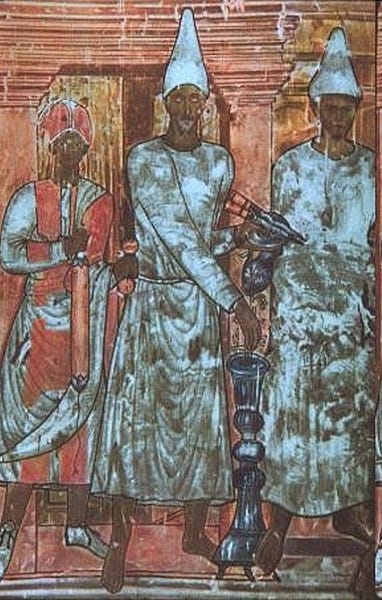
Μιθραϊστές ιερείς (: Μάγοι) ιερουργούν στον Ναό του Μπάαλ της Δούρας Ευρωπού όπως επήλθε αρχικά η ταύτιση του αραμαϊκού Μπάαλ με τον ιρανικό Μίθρα
Πολύ πριν αναγραφούν οι πρώτες από τις σωζόμενες επιγραφές και πολύ πριν φιλοτεχνηθούν τα πρώτα από τα σωζόμενα ανάγλυφα, αγάλματα και τοιχογραφίες του Μιθραίου της Δούρας Ευρωπού, Έλληνες μιθραϊστές πειρατές του 1ου προχριστιανικού αιώνα είχαν επιβάλλει τα Μυστήρια του Τριπλάσιου (: Τριαδικού) Μίθρα σε όλη την Ελλάδα, βεβηλώνοντας κι ακυρώνοντας την ιερότητα όλων των σημαντικών αρχαίων ελληνικών ιερών.
Ελληνικής καταγωγής βασιλείς του Πόντου και της Κομμαφηνής στον άνω ρου του Ευφράτη είχαν ήδη εδώ και αιώνες στεφθεί ως Ασιάτες πιστοί εν Μίθρα (: Μιθριδάτης) ηγεμόνες. Έτσι, κι οι Έλληνες της Συρίας, όπως λεγόταν παλιότερα η απέραντη σελευκιδική αυτοκρατορία που το δυτικό τμήμα της προσαρτήθηκε στην Ρώμη και το ανατολικό ενσωματώθηκε στο αρσακιδικό Ιράν, παράτησαν τον Δία και τον Απόλλωνα και γονάτισαν προ του Υπέρτατου Μίθρα.
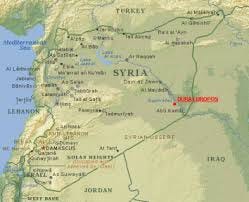
Δεν το έκαναν τυχαία: είχαν δει την συντριπτική υπεροχή των Μάγων του Μίθρα οι οποίοι ως απόλυτοι πανεπιστήμονες εκείνων των χρόνων, τέτοιοι που δεν υπήρξαν ποτέ στην Αρχαία Ελλάδα, θεουργούσαν αποδεικνύοντας όλες τις δυνατότητες συνέργειας ψυχής και σώματος και στα τρία επίπεδα της ψυχικής ύπαρξης. Τέτοια ‘θαύματα’ μόνον Ιρανοί έκαναν στα χρόνια της Ύστερης Αρχαιότητας.
Σχετικά:
Ταυροθυσίες και Μιθραϊκά Μυστήρια στην Κορυφή του Ολύμπου — Η Απόλυτη Επιβολή του Περσικού Πνεύματος ανάμεσα στους Έλληνες & το Τέλος της Αρχαίας Ελλάδας
https://greeksoftheorient.wordpress.com/2019/05/06/ταυροθυσίες-και-μιθραϊκά-μυστήρια-στ/
(αναδημοσιευμένο εδώ: https://www.academia.edu/62212919/Ταυροθυσίες_και_Μιθραϊκά_Μυστήρια_στην_Κορυφή_του_Ολύμπου_Η_Απόλυτη_Επιβολή_του_Περσικού_Πνεύματος_ανάμεσα_στους_Έλληνες_and_το_Τέλος_της_Αρχαίας_Ελλάδας)
Μίθρας, Μιθραϊσμός & Μιθραϊκά Μυστήρια: Όλα τα Αρχαία Ελληνικά και Λατινικά Κείμενα που αναφέρονται στον Μίθρα και τους Μιθραϊστές
https://greeksoftheorient.wordpress.com/2019/05/07/μίθρας-μιθραϊσμός-μιθραϊκά-μυστήρι/
(αναδημοσιευμένο εδώ: https://www.academia.edu/62259348/Μίθρας_Μιθραϊσμός_and_Μιθραϊκά_Μυστήρια_Όλα_τα_Αρχαία_Ελληνικά_και_Λατινικά_Κείμενα_που_αναφέρονται_στον_Μίθρα_και_τους_Μιθραϊστές)
Η Απόλυτη Κυριαρχία των Μιθραϊστών Πειρατών στο Αιγαίο, την Ελλάδα και τον Θεσσαλικό Όλυμπο στον 1ο Αιώνα π.Χ. — Τι λέει ο Πλούταρχος
https://greeksoftheorient.wordpress.com/2019/05/07/η-απόλυτη-κυριαρχία-των-μιθραϊστών-πε/
(αναδημοσιευμένο εδώ: https://www.academia.edu/62228155/Η_Απόλυτη_Κυριαρχία_των_Μιθραϊστών_Πειρατών_στο_Αιγαίο_την_Ελλάδα_και_τον_Θεσσαλικό_Όλυμπο_στον_1ο_Αιώνα_π_Χ_Τι_λέει_ο_Πλούταρχος)
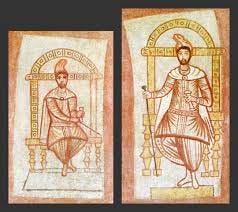
Ο Σέλευκος Νικάτωρ ανήγειρε την Δούρα Ευρωπό ως μεγάλη στρατιωτική βάση και εμπορείο — καραβανούπολη πάνω στον δρόμο που οδηγούσε από την Αντιόχεια προς την Σελεύκεια. Όμως τελικά τα θρησκευτικά μνημεία που σώθηκαν στην τεράστια πολιτεία πάνω στον μέσο ρου του Ευφράτη, στα ανατολικά άκρα της σημερινής Συρίας, επεσκίασαν και την εμπορική — οικονομική σημασία της και την στρατιωτική χρησιμότητά της.
Ο Μιθραϊσμός ήταν η επίσημη θρησκεία (ως Sol Invictus) της Ρωμαϊκής Αυτοκρατορίας πριν την άνοδο της Χριστιανωσύνης. Οι ομοιότητες ανάμεσα στην Επίσημη Χριστιανωσύνη και τον Μιθραϊσμό είναι πολλές και δεν είναι συμπτωματικές. Όμως αυτό δεν αποτελεί τίποτα το περίεργο. Πατέρες της Χριστιανικής Εκκλησίας έχουν αναφερθεί στο θέμα ήδη πριν από 1600=1700 χρόνια!
Αλλά η λειτουργικότητα ενός δογματικού στοιχείου κρίνεται από την ηθική των πιστών. Μπορεί και ο Μίθρας και ο Ιησούς να γεννιούνται κατά την επίσημη εκδοχή των δύο δογμάτων στις 25 Δεκεμβρίου, μπορεί αμφότεροι να θυσιάζονται, μπορεί αμφότεροι να αναλαμβάνονται, μπορεί να έχουν αμφότεροι ένα Μυστικό Δείπνο, μπορεί και οι δύο να προέρχονται από Άμωμη Σύλληψη, μπορεί και οι δύο να κάνουν θαύματα, μπορεί και οι δύο να είναι μέλη ενός Τριπλάσιου ή Τριαδικού Θεού, αλλά η αληθινή διάσταση μιας θρησκείας είναι πολύ πίσω, πολύ πέρα, και πολύ πάνω από αυτές τις ομοιότητες. Η στροφή των πιστών προς την Ηθική ή την Ανηθικότητα κρίνει τον ρόλο μιας θρησκείας.
Δεν υπάρχουν οι άνθρωποι για το Δόγμα αλλά το δόγμα για τους Ανθρώπους.
Και αν ακόμη πιστεύοντας δυο πανομοιότυπες θρησκείες οι μεν στρέφονται προς το Φως της Ηθικής και οι δε οδηγούνται στο Σκότος της Ανηθικότητας, οι ομοιότητες αποδεικνύονται επιφανειακές. Στο θέμα του Μιθραϊσμού, του δόγματός του, των μυστηρίων του, και της καταλυτικής παρουσίας του στην Ευρώπη θα επανέλθω. Στην συνέχεια αναδημοσιεύω άρθρα σχετικά με το Μιθραίο της Δούρας Ευρωπού το οποίο δεν είναι μόνον ένα κορυφαίο μνημείο της παγκόσμιας πολιτισμικής κληρονομιάς. Είναι επίσης η αφετηρία μιας νέας ερμηνευτικής προσέγγισης εντός του Ορεινταλισμού και της Ιστορίας των Θρησκειών. Άλλωστε, οι δυο πρώτοι ανασκαφείς ήταν κορυφαία πρόσωπα της επιστήμης του 20ου αιώνα: Franz Cumont και Michael I. Rostovtzeff.
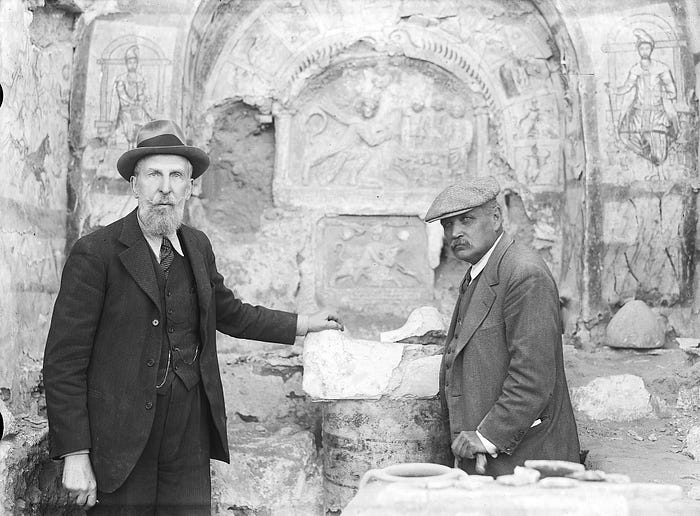
Franz Cumont (αριστερά) και Michael I. Rostovtzeff (δεξιά) στην ανασκαφή του Μιθραίου της Δούρας Ευρωπού
— — — — — — — — — — — — — — — — — — — -
Διαβάστε:
Dura Europos
In February 1934 a Mithraeum was discovered on the N.W. side inside the rampart of Dura-Europos (Es-Sâlihiyeh) between gate 24 and 23. After the excavations it was transported to New Haven, Gallery of Fine Arts of Yale University.
Rostovtzeff in RM 49,1934, 180ff; cf. BCR 1934 (Not.) 121f; AJA XXXIX 1935, 4f; 147; 259f and 293ff; Mouterde in MUSJ XIX, 1935, 123f; Dussaud in Syria XVI, 1935, 313ff; Cumont in CRAI 1934, 90ff; Hopkins in ILN 8 Dec. 1934, 963ff; du Mesnil du Buisson in GBA 1935, 1ff; CRAI 1935, 275ff; Watzinger in die Welt als Geschichte II, 1936, 397ff; Rostovtzeff e.o. Report, 62ff; cf. P. Koschaker in OLZ 1941, 271ff; Merlin in JS 1940, 36ff. Professor C. B. Welles informs me of the fact, that a final report is in preparation. We have drawn our description from the preliminary report. See fig. 7.
We are highly indebted to Prof. C. B. Welles and Miss Ann Perkins for sending us photographs of the finds.
General plan and history of the Mithraeum.
Rostovtzeff in RM 1934, 180ff and fig. 1; D-E, Pl. II and fig. 6; CRAI 1934, 91ff; GBA 1935, 6ff and fig. 2; Report, 62ff and figs. 29–35, Pls. I and III, 1, from which our, figs. 8–9.
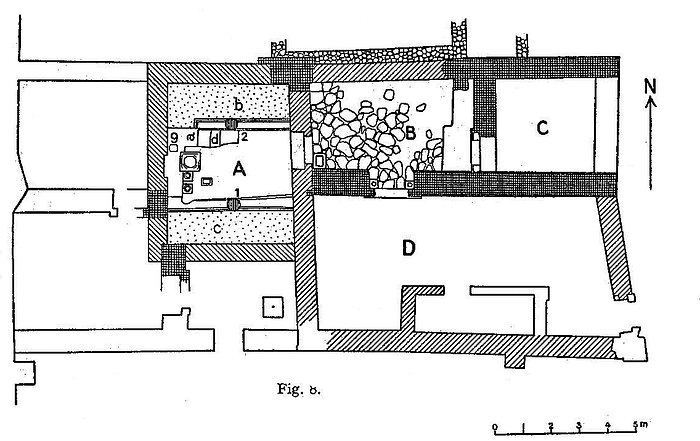
“When the Mithraeum was founded in about 168 A.D. (see inscr. №39) it consisted of three apartments (see plans 8, 9). Room A (L. 4.65 Br. 5.80), the Mithras shrine, was entered by an axial door through a partition separating it from a central chamberB (L. 5.75 Br. 3.50), originally a house diwan, that opened into a courtyard D to the south, and a small chamber C. (L. 3.50 Br. 3.50) to the east”.
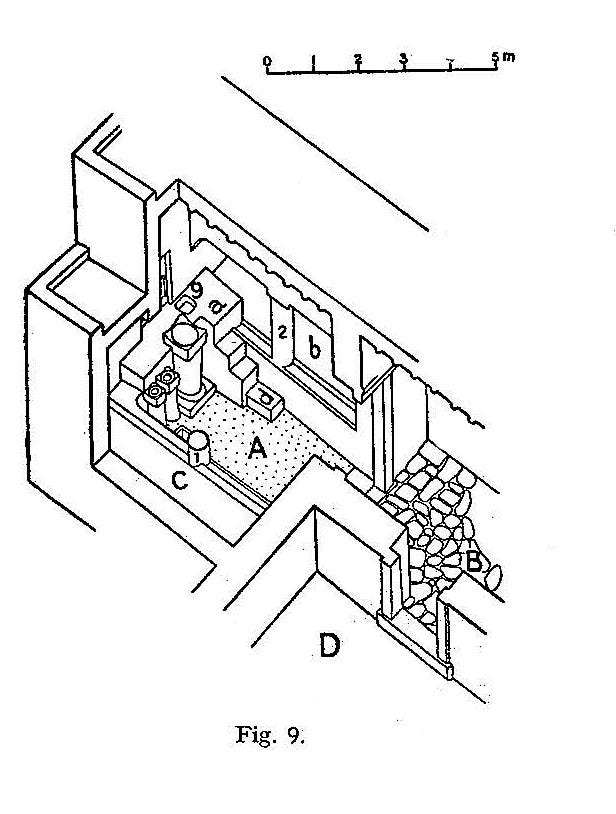
A was divided into three parts: a paved passage with on either side the benches band c (H. 0.72 Br. 1.70), in which the columns 1 and 2 had been built to support the ceiling, which was approximately 1.65 high over their benches, but about 1.60 higher over the central aisle.

Via the stairs d a rectangular, raised platform a (H. 0.88), in which a round well 9 (diam. 0;32). In front of a stood the main altar with two smaller side-altars, whereas against the backwall two reliefs had been fixed (see infra).

About 210 A.D. (see inscr. №53) a first rebuilding took place, because in the general destruction of the quarter the early Mithraeum was also destroyed (see fig. 10). The entire sanctuary was enlarged considerably. “The new alterations consisted of adding an antechamber B to the Mithras shrine by taking out the dividing partition and adding two more columns 3 and 4 on the foundations ofthat wall (L. 10.90); of building a small room E (L. 5.60 Br. 1.65) on the south and a low bench on the north of this new addition (H. 0.40 Br. 1.70); of turning the east chamber C into a vestibule and porch; of constructing an arched niche back of the altar; and of redecorating the entire chamber”.
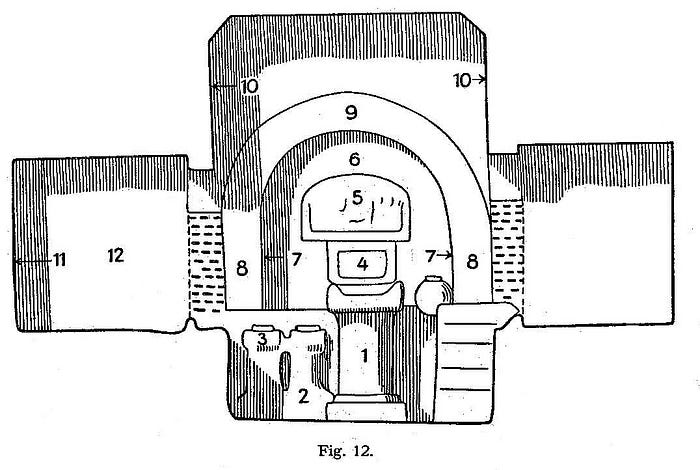
Opposite a rectangular recess (L. 1.25 Br. 0.75) in the new podium, there was a basin 10 in the middle of the paved floor (Diam. 0.32). another basin 11 was situated in the former room C. Underneath the columns 3 and 4 two altars e and t were placed.

Finally in ca. 240 A.D. a second reconstruction took place, which resulted in the definitive shape of the sanctuary (see fig. 11).
“It is probable that the roof was removed and altered for the construction of the new vaulted spelaeum and the additional columns (5, 6, 7, 8).
In the Late Mithraeum, the chamber of the south E was entirely removed and in its place was built a bench, probably low; the low bench on the north side was heightened to the level of the upper benches; two more columns were added to either side, making the chamber more symmetrical; two chambers F (L. 3.25 Br. 6.00) and G (L. 2.50 Br. 6.00) to the north of the building, the earlier history of which is obscure, were joined to the Mithraeum, a narrow passageway being cut through the benches leading to a newly pierced doorway.
For the new altar-table the aisle between the benches was filled up to the bench level as far as the first pair (I, 2) of columns and a stair of seven steps was built against the face of this platform. Between the first pair of columns and the wall were built partitions that supported a vault covering the new raised platform” .
When the walls behind the Mithraeum had to be strengthened against the impendency of the Persians under Sapor, the sanctuary got buried under the sand at the capture of the fortification in 256 A.D.
We now proceed to a detailed description of the most important part of the sanctuary; the elevated altar niche (see figs. 12 and 13).
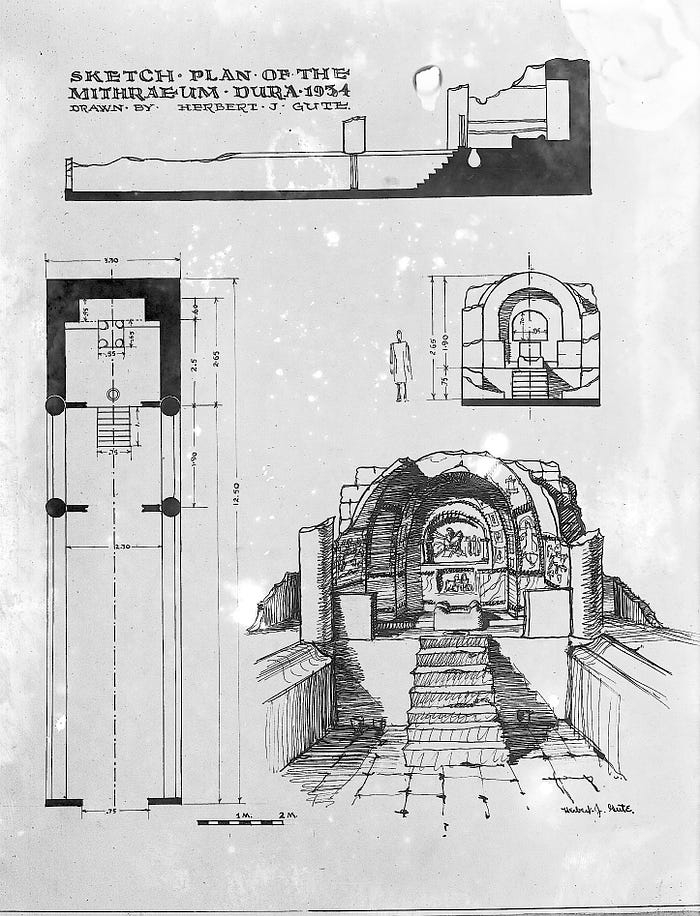
Rostovtzeff in RM 1934, 184ff and Pl. 11; ILN 1934,963; AJA 1935, Pl. IV; GBA 1935, fig. 5; Report, 79 and Pl. II and fig. 36.
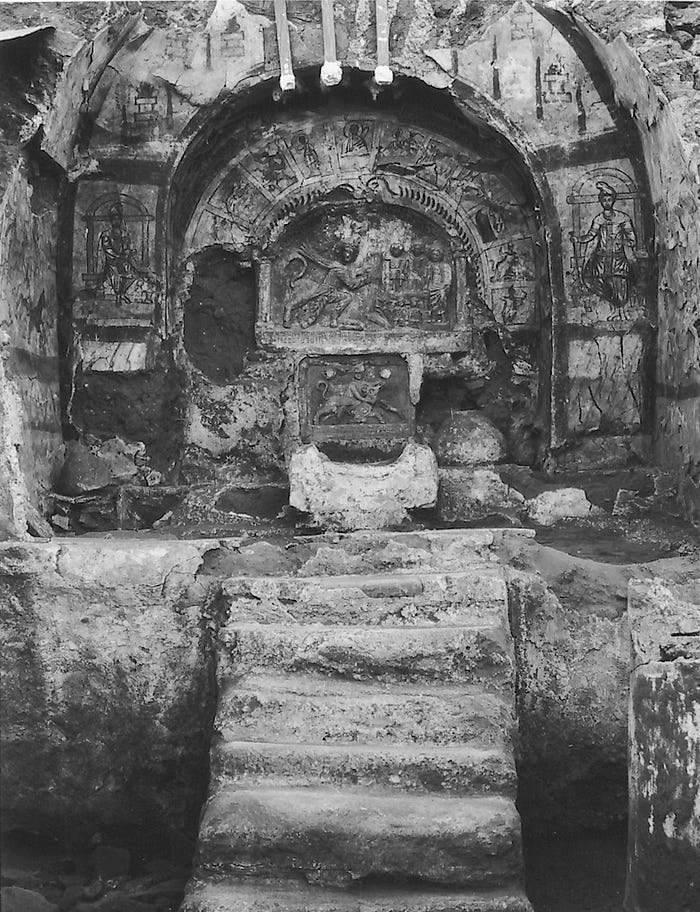
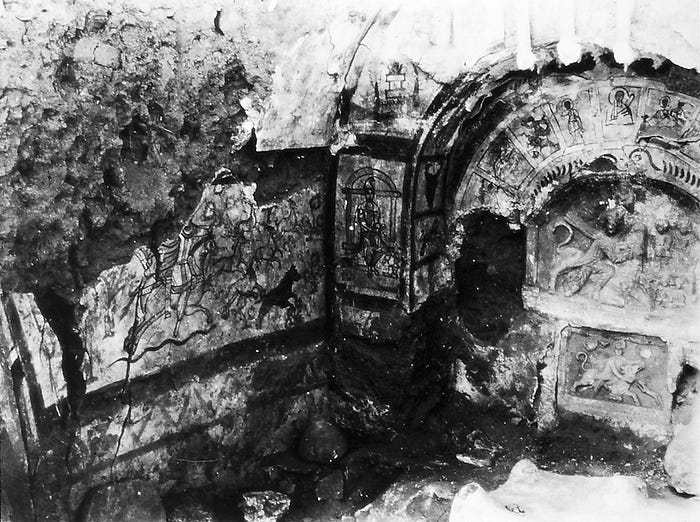
— — — — — — — — — — — — — —
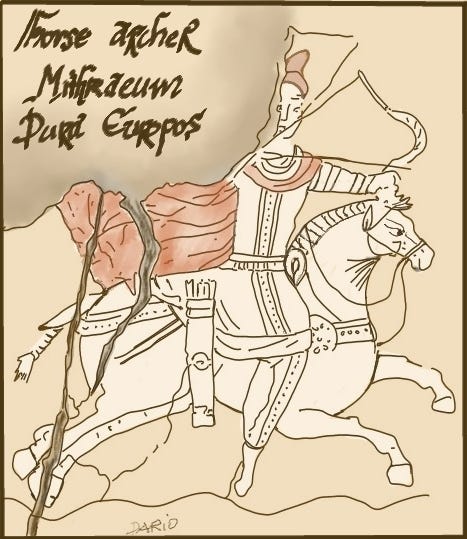
Mithraeum at Dura-Europos
Originally an Iranian god, Mithras became especially popular in the Roman period among soldiers and the merchant class. It is not surprising, therefore, to find that he had a special status in the military garrison at Dura-Europos.

In 1933–34, during the seventh season of the excavations at Dura-Europos by Yale University and the French Academy of Inscriptions and Letters, a small shrine to Mithras was discovered along the western fortification wall in the northern part of the city. A dedicatory inscription found there, dated about A.D. 168–69, shows that the shrine was sponsored by Palmyrene archers who served in the Roman army.

There is no evidence of any earlier Mithraeum; it seems safe to assume that the god Mithras was not worshipped in Parthian Dura-Europos but came to the city with the Romans. The Mithraeum was rebuilt and augmented after the enlargement of the garrison in A.D. 209–11. An inscription from this phase shows that the dedicant of the renovation was a centurion named Antonius Valentius.
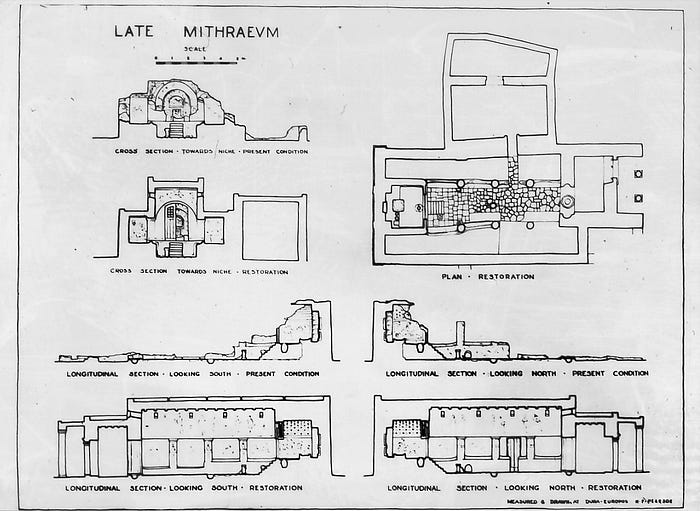
The building underwent yet another reconstruction and enlargement around A.D. 240. The decorations from this final phase were preserved by a defensive dirt embankment when the city was conquered by the Sassanians around A.D. 256 and are now part of the Yale University Art Gallery’s Dura-Europos Collection.
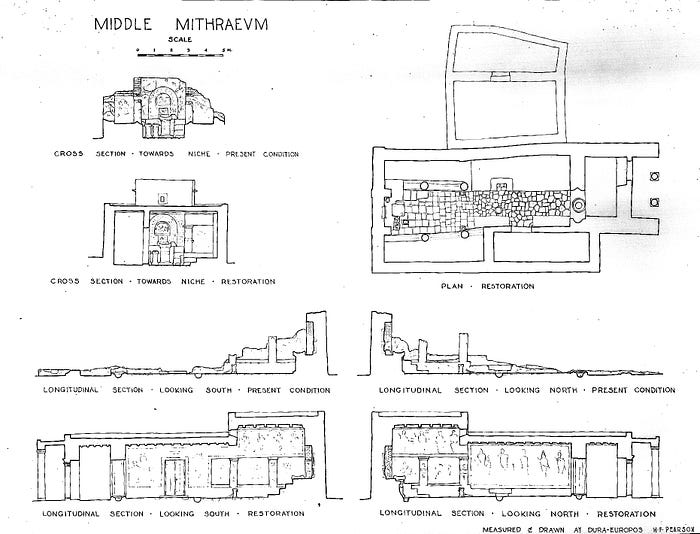
The cult of Mithras was a mystery religion that featured initiation, banquets, and the promise of salvation after death. Only men were allowed to join. Due to the exclusive nature of the cult, little is known about its rituals. There were seven levels, or grades, of initiation; graffiti at Dura-Europos listed names of initiates, given along with their Mithraic grade. Shrines dedicated to Mithras were generally located underground, commemorating the god’s birth in a cave; the Dura-Europos Mithraeum was unusual in that it was totally above ground.
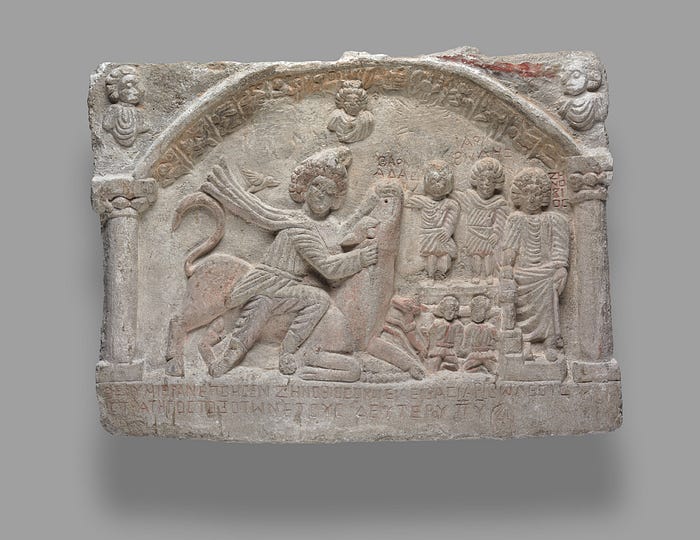
The devotional focus of a Mithraic shrine was typically a cult relief showing Mithras slaying the Cosmic Bull (in a depiction known as the tauroctony), which symbolized the victory of light over primeval darkness.

While iconographic schemes varied among Mithraic shrines in different locations, this image was a constant. The Dura-Europos Mithraeum contained two such reliefs (at right). Their inscriptions show that they date from the earliest phase of the shrine. The only surviving elements of that phase, the reliefs were reused as cult images in each subsequent renovation. Both show Mithras and the Bull in characteristic fashion: Mithras, dressed in Persian costume, sits on the back of the Bull and pulls his head back with one hand while he stabs the animal in the neck with the other. A small dog drinks blood from the wound. In the larger of the two reliefs, the donors or dedicants of the relief are shown observing the scene. Mithraic iconography from this period generally omits donor images, so their presence here is another deviation for which the Dura-Europos shrine is notable.

A series of paintings are showing scenes from the life of Mithras (including the slaying of the Bull, this time in a landscape with trees and altars), as well as representations of the signs of the zodiac, surrounded the reliefs.
The reliefs were flanked on both left and right by single seated figures who, like Mithras, wear Eastern dress. Russian scholar and Yale professor in the 1920s Michael I. Rostovtzeff proposed that the two were members of the shrine’s Palmyrene congregation, although others have suggested that they are prophets or magi.
On the side walls of the niche were two virtually identical scenes of Mithras as a mounted archer hunting wild animals in a wood. These hunting scenes are particularly Iranian in character and display an Eastern sensibility unlike other depictions of Mithras in the western Roman Empire. They emphasize the god’s role as divine archer, one that would have carried special meaning for the Palmyrene archers who worshipped him at Dura-Europos.
— — — — — — — — — — — — —
Κατεβάστε το κείμενο σε Word doc.:
https://vk.com/doc429864789_625488618
https://www.linkedin.com/posts/muhammad-shamsaddin-megalommatis-677982143_το-μιθραίο-της-δούρας-ευρωπού-activity-6881713788165382144-nQvs/




















No comments:
Post a Comment